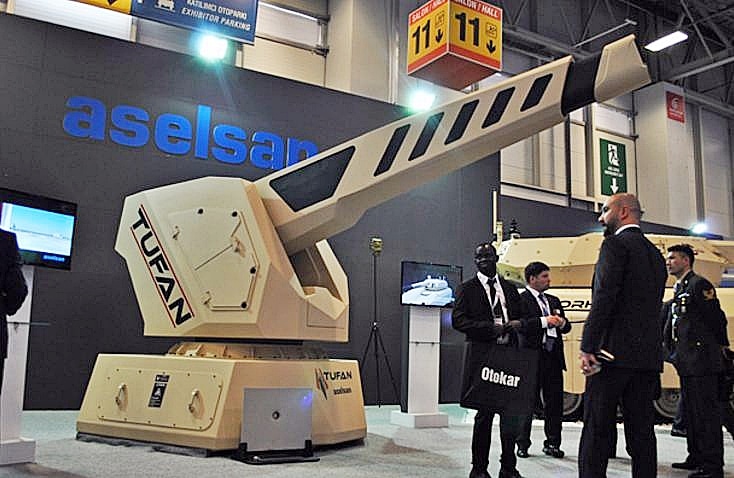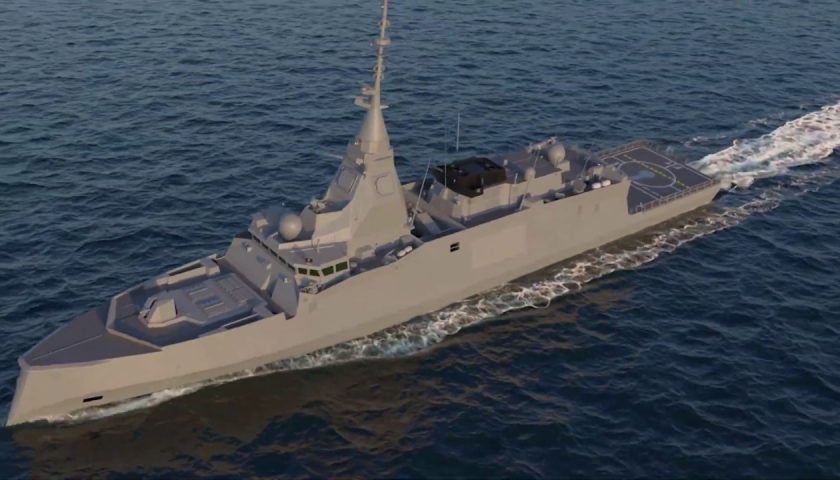Two electromagnetic gun demonstrators (or Railgun in English) were presented by Turkish companies at the 2017 and 2019 editions of the IDEF (International DEfence Industry Fair). They can both be “ game changer » for air defense, naval combat and deep, even strategic, strike in the Mediterranean Sea if they could equip Turkish warships in the mid-2020s.
Turkish work on electromagnetic technologies, particularly pulse power units, is said to have begun in 1972. A first demonstrator was developed in 2008. But it is the two demonstrators presented in 2017 and 2019 which are of the greatest interest. ASELSAN (Askeri Elektronik Sanayi or Military Electronics Industry) presented the Flood at the IDEF 2017 exhibition while Yeteknoloji unveiled the Sahi-209 at the 2019 edition of the same show.
ASELSAN (Askeri Elektronik Sanayi or Military Electronics Industry) founded in 1975 offers a lightweight electromagnetic cannon: the Flood, in development since 2014. Two operational uses are proposed. The first is to be able to serve on land as an artillery piece. The second is use for anti-aircraft defense. THE Flood could be supplied with smart munitions according to the manufacturer. The piece would be capable of firing shells weighing around 300 grams up to a range of 7250 meters and at a speed of 3000 ms-1 (Mach 8,7).

The use of such a part on board a warship does not seem to have been discussed publicly. The characteristics of such an electromagnetic gun for short-range anti-aircraft defense with shells fired at hypersonic speeds would make it possible to gain the upper hand over existing anti-ship missiles (subsonic and supersonic) but also to provide a first attempt at responding to hypersonic projectiles. Even maneuvering or hypersonic missiles designed to “stress” defenses by drastically reducing the target’s reaction time would have to face shells compensating for this reduction in reaction time with their intrinsic speed.
The second demonstrator was presented by Yeteknoloji. It has reportedly been in development since July 2018, which seems very low in relation to the efforts required to produce. Comparison is not right but, however, the air of resemblance of this Turkish demonstrator with the electromagnetic gun developed by the Institute 206 of the CASIC aerospace group in China is striking. Are they explained by the sole convergence towards the same technical choices?

Yeteknoloji therefore presented its own electromagnetic gun program at the IDEF 2019 show: the Sahi-209. This name refers to nothing less than the artillery piece which allowed the walls of Constantinople to be breached when the city was taken by Emperor Mehmet II in 1453.
Le Sahi-209 already exists in two versions. THE Sahi-209 Block 1 has a power of 1 megajoule allowing it to fire an ammunition of around 300 grams at almost 10 km. But it is the Sahi-209 Block 2 which turns out to be the most interesting. The increase in performance is significant since it is now a 35 mm shell weighing approximately 1000 grams which can be fired from a seven meter tube thanks to a power of 10 megajoules up to a range of 'about 50 km. The first tests on land were crowned with success, the Sahi-209 Block 2 was even presented to at least one delegation of specialists on October 9, 2019.

Next steps include integrating the Sahi-209 Block 2 on board an experimental vessel. Turkey follows in the footsteps of China, the first nation to have installed such a demonstrator aboard the LST Type 072III (Landing Support Tank or Tank Landing Building) from January 2018. It is interesting to note that the cannon of the Chinese experiment is an artillery piece almost 10 meters long, accompanied by several containers (TEU (Twenty-Foot Equivalent) arranged behind. And there is no indication whether the LST Type 072III's base is occupied - or not - by other equipment. The United States of America is the second nation to have announced experimentation with an electromagnetic gun, probably derived from testing of BAE Systems' ElectroMagnetic RailGun (EMRG). Initially planned to be installed in 2016 aboard a Janointed High Speed Vessel (JHSV) of the Spearhead class, the project was relaunched following the appearance of Chinese experimentation. The choice of building and the date of the American tests are not yet known.
The American and Chinese experiments have in common that they are testing at sea, rather than a demonstrator, a real prototype of an electromagnetic naval artillery piece. The two strategic competitors aim for a range of more or less 150 km, the most common range of subsonic anti-ship missiles. Unlike the Chinese tests, those of the US Navy, if they were to end up being carried out aboard a JHSV, would have the advantage of being theoretically able to be carried out at high speeds: up to more than 30, or even more than 40 knots. The two nations are aiming for a production model ready for use around 2025. The natural candidate in China to accommodate this part is an adapted version Type 055 destroyers. In the United States it would be an Arleigh Burke Flight III type destroyer. Or the three Zumwalt-class destroyers.

Back in Türkiye, the integration of the two artillery pieces – Sahi-209 Block 2 (naval combat, deep strike) and Flood (short-range anti-aircraft defense) – would allow future Turkish naval vessels to possess two advantages of military superiority over all other military buildings evolving in the Mediterranean.
Le Sahi-209 Block 2 has a shorter range than those targeted in China and the United States (~ 150 km). This may very well suit a light and fast vessel using the stealthy lines of its hull in order to get closer to adversaries spotted by external systems. It remains to be observed whether the second batch of MİLGEM corvettes (MİLli GEMi or national combat vessel) could be targeted by the integration of the Sahi-209 Block 2.
Another hypothesis, the sea trials of Sahi-209 Block 2 would be carried out in parallel with the study of a Block 3. The progression of technical characteristics between Block 1 (10 km) and 2 (50 km) followed a factor of 5 for the range and a factor of 3 for the weight of the shell. A possible Block 3 would meet the performances targeted by the Americans and Chinese. From this perspective, integration would require a building with larger dimensions. The most likely hypothesis is the air defense frigate program, the schedule of which can easily correspond with the provision of an electromagnetic gun in the mid-2020s.

The blocking point is that it is also a question of developing, in parallel, an integrated system of electrical production so that the energy necessary to power the cannon can be produced continuously, stored and delivered on the date when the order is given to fire, for example in salvos. Turkey does not present a warship program with propulsion using these technological building blocks. There is reason to question the maturity of Turkish industrial capacities in order to support these developments in the mid-2020s. Aiming for the early 2030s seems more prudent.
In relation to the strategic competition between Greeks and Turks, Athens could regain the advantage by admitting to active service Defense and Intervention Frigates (FDI) equipped with a digital flat-face radar. This is capable of tracking objects moving at hypersonic speeds but also of offering a counter-battery radar function. The sensors would already follow a possible electromagnetic cannon, it remains to ward off the blows. All this would force Ankara not to delay too much its air defense frigate program, which was to be launched in 1998.
Furthermore, a possible addition to the Turkish military programming of electromagnetic cannons raises the question of the ranges considered for possible future strategic strikes from one coast to the other of the Aegean Sea. And therefore joint capabilities regarding air defense against objects moving at hypersonic speeds. The Greek Navy will therefore remain in demand for air defense vessels responding to these threats. And probably, through the phenomenon of imitation, also in demand for electromagnetic cannons.
